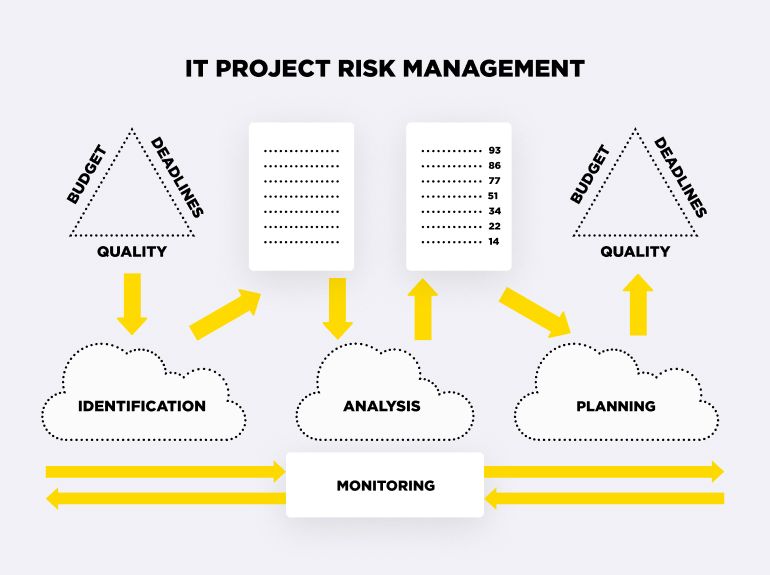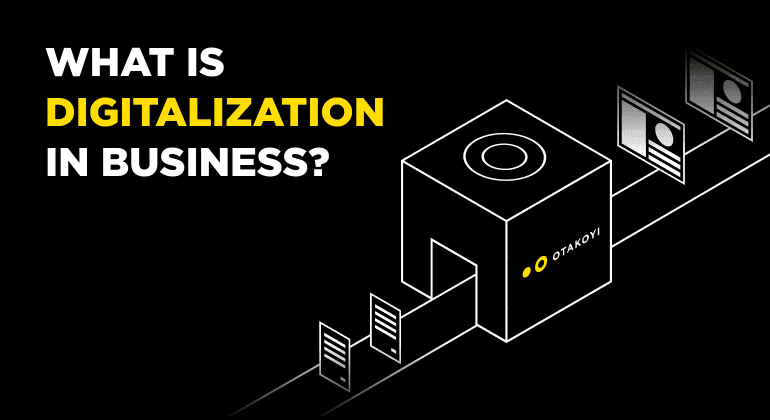To effectively manage a software development project, one must manage its risks. Indeed, a Project Manager’s (PM) performance can be reduced to one thing — a constant fight against risks that can prevent the project from being completed on time, within the planned budget and scope, with the required level of quality, etc. If there were no risks in a project, then there would probably not be a need for a PM, but I’m not sure that such types of projects even exist. Be it in one way or another, you always encounter various risks during software development.
For this reason, today I want to talk a little more on how to manage project management risks in IT projects and explain why is risk management important when managing IT projects:
What Is Risk Management In IT Project Management?
The success of an IT project depends on many factors, but I believe that these three are the main ones: time, quality, and financial resources. Balancing them with each other is always difficult, which is why the saying “choose two out of three” is quite popular. If the focus is on the high quality of all work on the project, then this will either require a lot of time or a lot of resources. The main task of the project manager is to meet the allocated budget and the specified time frame and ensure the required quality with the available labor resources. Any violation of these restrictions is fraught with various kinds of risks. Hence, risk management in IT projects is crucial since it allows identifying and analyzing potential risks, as well as creating efficient strategies to either avoid a\or eliminate possible negative consequences of risks.
Common Project Management Risks
Risks in the implementation of IT projects can be divided into three groups:
Risks associated with the pace of the development process;
Risks associated with the quality of the product being developed;
Risks associated with the development budget.
A shift in emphasis on one group causes a change in the other two. If you want a project quickly and cheap, get ready for the corresponding quality. If you need to quickly get a high-quality result, ensure that you have the required budget at hand.
Let’s stop here for a moment to see what these 3 common risks imply.
Timing
Timelines are getting shorter these days. IT outsourcing projects are becoming larger and deeper integrated into the business ecosystem. The focus today is no longer just to automate business processes, but to make them as efficient as possible in a short time. Business not only develops digital products — it strives to create unique offers for customers and get them to market faster than competitors. That is why the timing of the project is becoming increasingly important. If competitors release a similar product earlier, all efforts will be wasted. That is why it is important to consider all possible project risks and estimate a realistic deadline. Otherwise, you risk not meet the time frames and thus waste the entire effort.
Quality
Quality requirements are constantly growing. Today, a quality product means more than a user-friendly UI/UX, high performance, security, and availability. In order to make a high-quality product, you need to understand its logic and place in the overall ecosystem of a company or market and take into account its prospects. That is why there should be a firm manager’s grip over the development process to meet all project quality requirements and be able to satisfy high expectations.
Moreover, the market is changing, new services appear, technologies are developing, and if the product does not include the possibility of development, integration, or updating, there is a risk that soon it will become outdated and not able to match the market demand.
Budget
Business stakeholders expect financial results from their investments, and the risks associated with budget overruns are attracting more and more attention these days due to the effect of the pandemic. Sure thing stakeholders do not want to invest in a “budget black hole” project or endlessly continue investing in projects that are “almost” completed. They need a clear understanding of how the budget is allocated: what specialists are involved, what technologies are used, how the volume and time of work are taken into account. Of course, there are always risks of budget overrun due to various development obstacles. That is why a project risk manager should always carefully take into account all of the possible issues that might be encountered during the project progression and estimate the right budget beforehand.
IT Project Risk Management Strategies
There are numerous useful and effective strategies to manage risks during software project development. These are IT project risk management best practices that are commonly used:
Evasion strategy
The evasion strategy involves the complete elimination of risk from the project. We must come up with a response that makes sure the risk does not materialize. This is the most demanding strategy because, for some risks, it forces you to abandon certain tasks, change the goals of the project or, in the most radical case, even abandon the project.
Reduction strategy
It is the most common and can be applied to any risk, as it implies a reduction in the likelihood or impact of the risk on the project.
Transfer strategy
Transfering the consequences of risk materialization and responsibility for the response to a third party. The risk itself is not eliminated. The transfer of risk almost always implies the financial costs of transferring and obtaining financial compensation in the event when the risk materializes.
Acceptance strategy
There are two options for the acceptance strategy in the IT project management project risks:
Active acceptance. A reserve of time and financial resources is formed to eliminate the consequences of risk materialization.
Passive acceptance. Assumes a plan “B” in case the risk materializes.
As a rule, it is better to be armed with several strategies/approaches to make sure that they cover one another's weak spots.
IT Project Risk Management Process

The IT risk project management process consists of 4 steps: Identification, Analysis, Planning, and constant Monitoring. If you are looking for an in-depth understanding of these steps, I would recommend checking the following, extended version of project risk management examples.
Risk identification
The purpose of this stage is to identify a number of unknown project risks. What we do is accept that there are infinitely many potential issues that might or might not occur during the development process, so we approach this task quantitatively. At the beginning of the project, we often try to make a list and identify 50-100 risks. And with this list, we begin the real process:
The project manager conducts a meeting with the whole team;
PM reports on the status of the project, current risks, and problems, answers questions;
The meeting participants voice potential risks. All ideas are accepted without exception, without discussions and comments;
The PM records the results in a cause-risk-effect format. As soon as the goal is achieved, or the time has expired, the meeting ends;
Result: an updated list of risks in the “cause-risk-effect” format.
Risk analysis
Of course, dealing with all the risks at once is expensive and ineffective. The purpose of this stage is to identify the most important ones. That’s where the risk analysis and management in IT projects begins. We should take into account the Probability and Consequences of each risk to understand and evaluate its Importance. Thus we will know which risks are critical and then work only with them.
PM gathers a meeting with team leads;
PM announces the risks one by one, and participants assess their probability and consequences;
After the meeting, PM evaluates the Importance on a scale up to 100 points based on the Probability and Consequences;
Result: a list of critical risks and their importance points.
Risk planning
For each risk from the list of critical ones, it is necessary to come up with a strategy that will protect our project from it.
PM conducts a meeting with leads;
The PM announces the risk, the rally participants determine the strategy for working with it, the main plan and the backup plan;
PM updates the project plan, adding basic risk plans;
Result: a list of critical risks with a strategy and plan for each risk, an updated project plan;
Monitoring
It is more of a process than a stage. Its purpose is to keep the risk list and project plan up to date.
PM revises the list of risks, updates assessments, updates outdated plans;
PM identifies occurred risks, makes a decision on the implementation of backup plans, updates the project plan;
Result: an updated list of risks, an updated project plan.
Wrapping It Up
Plans and risks are an inextricable duo. There is no plan that goes without risk/risks. However, with a professional risk management approach, risks are nothing but the identified and assessed threats consistent with the chosen course of action. If you have identified the threats and prepared your project to either avoid or stand against possible risks, they can no longer mess up your plans.
OTAKOYI provides outstanding risk management services. We are proficient both at theory and practice. We’ve been there, we’ve done that. And what is more important, we can help you with it.





